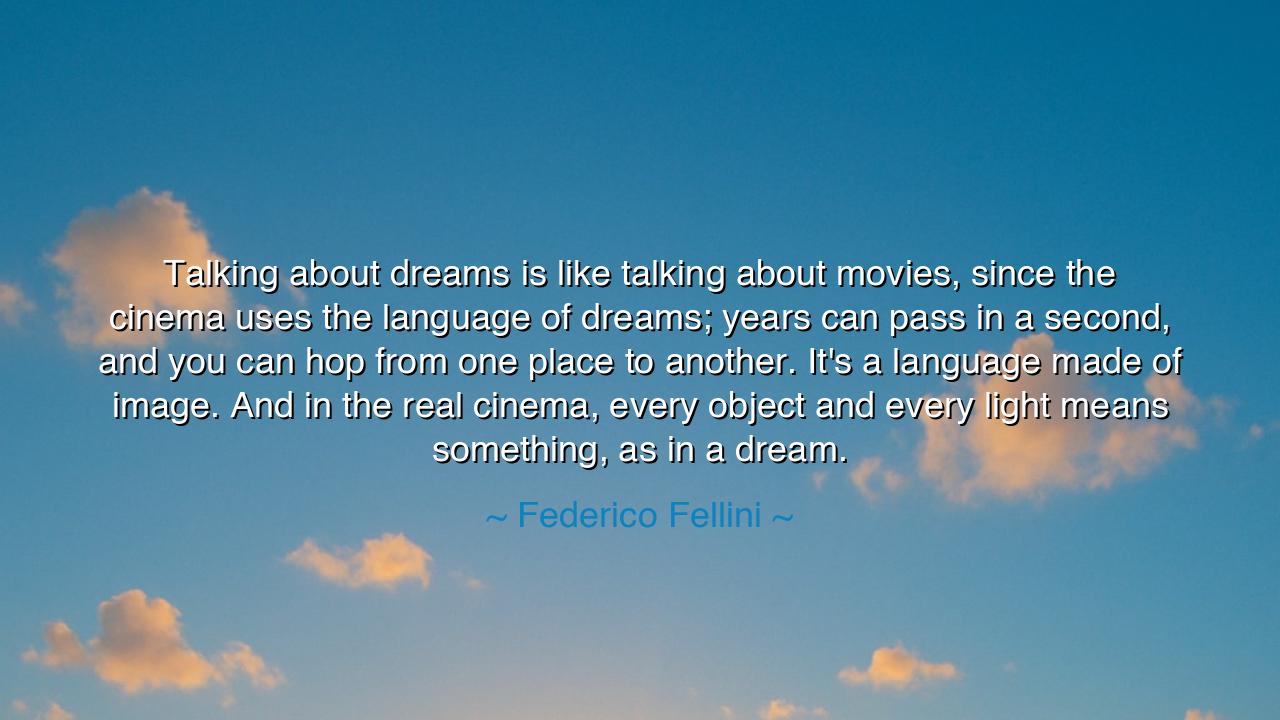
Talking about dreams is like talking about movies, since the
Talking about dreams is like talking about movies, since the cinema uses the language of dreams; years can pass in a second, and you can hop from one place to another. It's a language made of image. And in the real cinema, every object and every light means something, as in a dream.






The Italian master Federico Fellini, in his wisdom, once declared: “Talking about dreams is like talking about movies, since the cinema uses the language of dreams; years can pass in a second, and you can hop from one place to another. It’s a language made of image. And in the real cinema, every object and every light means something, as in a dream.” In these words, he reveals not merely an observation of art, but a philosophy of the human spirit — a truth that binds the realms of imagination, memory, and creation. To understand his saying is to peer into the very nature of vision itself — the mysterious power by which the soul transforms thought into image, and image into meaning.
When Fellini speaks of the language of dreams, he touches upon something ancient — the same mystery that haunted prophets and poets of old. In the visions of Jacob, the angels ascended and descended upon a ladder of light. In the dream of Pharaoh, seven lean cows devoured seven fat ones, foretelling famine. And so too in cinema, the artist gives form to what cannot be said in words: he speaks in symbols, in light, in movement. This is the sacred craft of storytelling — the alchemy of transmuting the invisible soul into visible form. In dreams and in film alike, the spirit paints truth upon the shifting canvas of time.
Behold how, in both dream and cinema, time bends and space folds. The dreamer drifts from one place to another without walking a single step; a lifetime may pass in the blink of an eye. So too does the filmmaker command the rhythm of time. In one cut, the child becomes an old man. In one dissolve, the battlefield turns to peace. It is as if the artist, like a god of his own creation, whispers: “Let there be light,” and a world springs into being. Such is the power of image — not mere decoration, but revelation itself.
Consider the tale of Sergei Eisenstein, the father of montage, who believed that film could awaken the collective soul of a people. In “Battleship Potemkin,” the fall of a mother upon the Odessa steps becomes the sorrow of a nation. The images do not simply show — they speak. Each shadow, each movement, each flicker of light bears the weight of history. The audience does not watch; they dream together, bound by emotion, guided by meaning beyond words. Just as in our own dreams, every symbol — a staircase, a smile, a shattered glass — holds its secret message.
And yet, Fellini warns us: only in real cinema, where every light and every object means something, does this dream-language retain its truth. For there is cinema that dazzles the eye but leaves the soul untouched — hollow spectacle without spirit. True art, he teaches, is not about illusion but revelation. It unveils the hidden patterns of the heart, the secret longings and fears that shape our waking lives. Like the dream that startles us awake, the true film stirs something eternal within us.
In this, Fellini speaks also of life itself. For is not life a dream, too — fleeting, strange, filled with symbols whose meanings we only begin to understand? The days blur together; we leap through years without noticing. What was once near becomes distant; what was forgotten returns in memory’s light. To live, then, is to walk through a cinema of the soul, where each encounter, each object, each glance is charged with hidden purpose. The wise one does not pass by blindly, but asks: “What does this light mean? What truth is being shown to me now?”
So let the lesson of Fellini be this: see with the eyes of the dreamer, and create with the hands of the artist. Whether you paint, write, speak, or live — remember that your life itself is a film unfolding before eternity. Every gesture, every word, every silence is part of the language of dreams. Let it have meaning. Let your light fall with purpose. Let no image in your life be without soul.
And when you wake tomorrow, or sit before your work, or gaze upon the faces of those you love, remember that you are both the dreamer and the director. Shape your life as Fellini shaped his visions — with wonder, with courage, and with faith in the power of image. For to live meaningfully is to master the sacred language of the dream.






AAdministratorAdministrator
Welcome, honored guests. Please leave a comment, we will respond soon